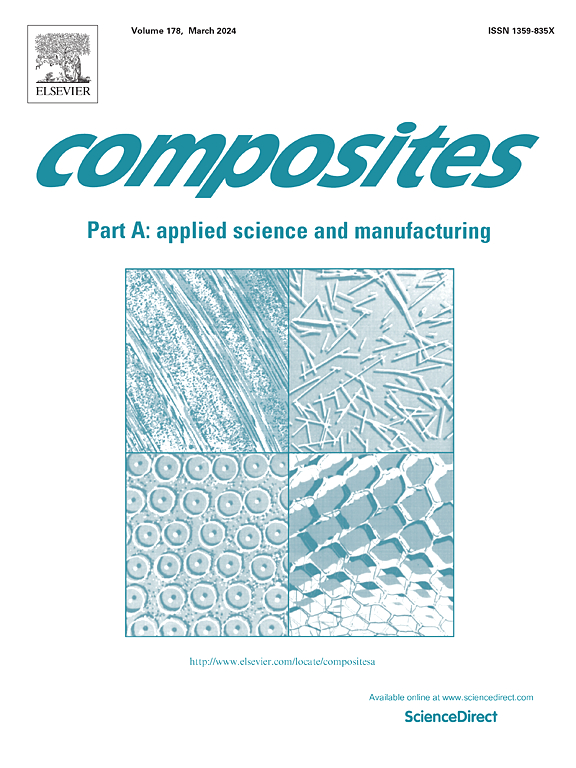三维打印连续纤维增强复合材料的工艺-结构-性能研究
IF 8.1
2区 材料科学
Q1 ENGINEERING, MANUFACTURING
Composites Part A: Applied Science and Manufacturing
Pub Date : 2024-10-18
DOI:10.1016/j.compositesa.2024.108538
引用次数: 0
摘要
与传统复合材料相比,三维打印纤维增强复合材料在个性化、大规模定制、设计自由度以及根据承重规格定制复合材料几何形状等方面具有许多优势。在候选的连续增强纤维中,玄武岩纤维(BF)是一种环保型替代纤维,具有优异的物理和热性能。然而,现有文献很少涉及连续玄武岩纤维在三维打印聚合物复合材料中的适用性。特别是制造过程中浸渍密度的影响以及局部纤维分布对 BF 增强复合材料断裂行为的影响仍不清楚。本研究采用溶液涂覆工艺作为纤维预处理,以提高聚乳酸(PLA)基体中 BF 的堆积密度。研究利用三维 X 射线断层扫描技术深入分析了纤维体积分数(8-31%)和局部纤维分布对 3D 打印 BF/PLA 样品拉伸断裂机制的影响。研究发现,在 3 wt% 的浓度下,涂层溶液均匀地分散在纤维之间,从而提高了 BF 在聚乳酸基体中的浸渍密度。因此,所得复合材料的拉伸强度和杨氏模量分别达到了 175 兆帕和 6.2 千兆帕。标准线性固体(SLS)模型用于复合材料设计框架内的性能预测,该框架将应用于三维打印 BF/PLA 结构。拉伸试验的实验数据对该模型进行了验证。研究结果表明,环保型 BF/PLA 复合材料适用于具有个性化属性特征的高性能工业应用 3D 打印。本文章由计算机程序翻译,如有差异,请以英文原文为准。
Process-structure–property study of 3D-printed continuous fiber reinforced composites
3D-printed fiber-reinforced composites hold many advantages compared to conventional composites in terms of individualization, mass customization, design freedom, and tailoring the composite geometry to load-bearing specifications. Among candidate continuous fibers for reinforcement, basalt fibers (BFs) serve as an eco-friendly alternative with excellent physical and thermal properties. However, the applicability of continuous BFs to be used for 3D-printed polymer composites was rarely addressed in existing literature. Especially, the effects of impregnation density during manufacturing and the influence of local fiber distribution on the fracture behavior of BF-reinforced composites remain unclear. In this study, a solution coating process was employed as a fiber pre-treatment to improve the packing density of BF in a polylactide (PLA) matrix. The effects of the resulting fiber volume fraction (8–31 %) and the local fiber distribution on the tensile fracture mechanisms of 3D printed BF/PLA samples are thoroughly analyzed using three-dimensional X-ray tomography. It was found that at a concentration of 3 wt%, the coating solution uniformly dispersed optimally between the fibers, resulting in improved impregnation densities of the BF in the PLA matrix. Thus, the resulting composite exhibited a tensile strength of 175 MPa and a Young’s modulus of 6.2 GPa, respectively. A standard linear solid (SLS) model is used for property prediction within a composite design framework to be applied to 3D-printed BF/PLA structures. The model is validated with experimental data from tensile tests. The obtained results demonstrate the applicability of eco-friendly BF/PLA composites for 3D printing of industrial high-performance applications with an individualized property profile.
求助全文
通过发布文献求助,成功后即可免费获取论文全文。
去求助
来源期刊

Composites Part A: Applied Science and Manufacturing
工程技术-材料科学:复合
CiteScore
15.20
自引率
5.70%
发文量
492
审稿时长
30 days
期刊介绍:
Composites Part A: Applied Science and Manufacturing is a comprehensive journal that publishes original research papers, review articles, case studies, short communications, and letters covering various aspects of composite materials science and technology. This includes fibrous and particulate reinforcements in polymeric, metallic, and ceramic matrices, as well as 'natural' composites like wood and biological materials. The journal addresses topics such as properties, design, and manufacture of reinforcing fibers and particles, novel architectures and concepts, multifunctional composites, advancements in fabrication and processing, manufacturing science, process modeling, experimental mechanics, microstructural characterization, interfaces, prediction and measurement of mechanical, physical, and chemical behavior, and performance in service. Additionally, articles on economic and commercial aspects, design, and case studies are welcomed. All submissions undergo rigorous peer review to ensure they contribute significantly and innovatively, maintaining high standards for content and presentation. The editorial team aims to expedite the review process for prompt publication.
 求助内容:
求助内容: 应助结果提醒方式:
应助结果提醒方式:


